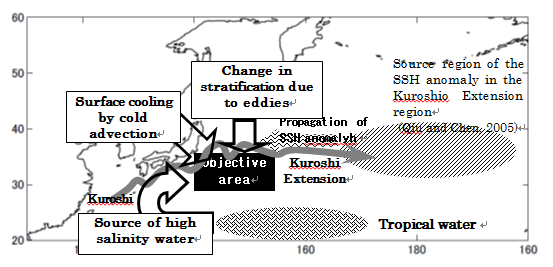Study of long-term variability in the oceanic mixed layer to the south of the Kuroshio Extension
| A02-K4. Study of long-term variability in the oceanic mixed layer to the south of the Kuroshio Extension | |
|---|---|
| PI | Naoto IWASAKA* (Professor, Tokyo University of Marine Science and Technology) |
[Doctral degree: *Oceanography]
Introduction
Processes in a surface mixed layer of ocean affects the atmospheric conditions above through determines the sea surface temperature and constructs the thermal structure of the ocean by producing water masses. One of the key regions of such air-sea interaction is the area south of the Kuroshio Extension, where the North Pacific Subtropical Mode Water (NPSTMW) forms and more than 300W m-2 of heat is released to the atmosphere in late winter. Previous studies have revealed that interannual variations of the surface mixed layer in the region in cold season has been strongly controlled by interannual changes in surface cooling and those of subsurface stratifications. Iwamaru et al. (2010) have pointed out that the dominant factors seem to change around 1990, i.e., after around 1990, variations of subsurface stratification in the region dominated the interannual variation of the mixed layer while before 1990 the effects of surface cooling and the variation of the stratification are comparable.
Issues
Several issues to be addressed on the mixed layer variations in the region to the south of the Kuroshio Extension have emerged after the work of Iwamaru et al. (2010).
- (i) Did the mechanisms determining the mixed layer in the region really change around 1990 and what is the cause?
- (ii) How does the interannual variation of the mixed layer affect the atmospheric circulation and the structure of the internal ocean?
- (iii) What is the variation of the salinity in the mixed layer and how does the salinity variation contribute the formation of the NPSTMW?
Purposes of the present study
- (i) To investigate what really happened in the mixed layer south of the Kuroshio Extension and to reveal the causes or mechanisms in 40 years from 1970 to 2009.
- (ii) To understand the relationship among the variations of the oceanic surface mixed layer, atmospheric circulation and changes in the subsurface structure in the subtropical gyre.
- (iii) To draw how the salinity has changed in the mixed layer and the cause/mechanisms.
Possible contribution to the Project
The present study will contribute the promotion of the Project, particularly the subprogram A02-5.
References
Iwamaru, H., F. Kobashi and N. Iwasaka, 2010: Temporal variations of the winter mixed layer south of the Kuroshio Extension, J. Oceanogr., 66, 147-153.Qiu, B., and S. Chen, 2006: Decadal variability in the formation of the North Pacific Subtropical Mode Water: oceanic versus atmospheric control. J. Phys. Oceanogr., 36, 1365-1380.

| period | Researchers | Theory of contributing factors to interannual variations of the mixed layer in winter |
|---|---|---|
| ~2000 | Suga and Hanawa, 1995; Yasuda and Hanawa 1999; Taneda et al., 2000, others | Changes in vertical convection due to surface cooling in late winter <variations in atmospheric circulation |
| 2000' | Qiu and Chen, 2006; Kako and Kubota, 2006, others | Changes in surface stratification due to high vorticity water advected from the subarctic region by meandering the path of the Kuroshio Extension <propagation of SSH anomaly from the central North Pacific |
| 2010~ | Iwamaru et al., 2010 | Both surface cooling and change in subsurface stratification contribute the mixed layer variations but the contribution of the surface stratification dominates after 1990. |

